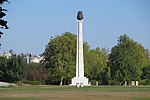Ušće Towers

The Ušće Towers (Serbian Cyrillic: Пословни центар Ушће, romanized: Poslovni centar Ušće) are two 25-story mixed-use skyscrapers located at Mihajlo Pupin Boulevard in the New Belgrade municipality of Belgrade, Serbia. The first tower, 98 meters tall, was the tallest building in Serbia until 1979 and construction of Genex Tower, and the second-tallest freestanding structure, after the Avala Tower. Construction of the second tower, designed as a twin of the first, began in 2018 and it was opened in June 2020. Built in 1964, the first Ušće Tower glass building overlooks the confluence (ušće in Serbo-Croatian) of Danube and Sava rivers from the New Belgrade side. It was originally used as the headquarters of the Central Committee of the League of Communists of Yugoslavia, which broke apart in 1990. Ušće was frequently leased out to commercial interests until 21 April 1999, when it was severely damaged by successive NATO air-strikes as part of the 1999 NATO bombing of Yugoslavia. Beginning in 2003, the tower was reconstructed, including a 2-floor increase (103,9m / 340,9 ft in total) in height, with the addition of a 26m antenna, which in strict architectural terms does not count as structural height, however, in structural height would actually be 103,9 m. The reconstructed tower is now being rented out to tenants.
Excerpt from the Wikipedia article Ušće Towers (License: CC BY-SA 3.0, Authors, Images).Ušće Towers
Mihailo Pupin Boulevard, Belgrade New Belgrade (New Belgrade Urban Municipality)
Geographical coordinates (GPS) Address Phone number Website External links Nearby Places Show on map
Geographical coordinates (GPS)
| Latitude | Longitude |
|---|---|
| N 44.816111111111 ° | E 20.436944444444 ° |
Address
УШЋЕ шопинг центар
Mihailo Pupin Boulevard 4
11070 Belgrade, New Belgrade (New Belgrade Urban Municipality)
Central Serbia, Serbia
Open on Google Maps









